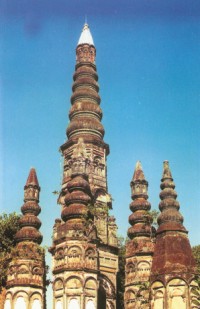Book launch
Bringing temples into focus
Cultural correspondent
The book launching ceremony of Kantajee Temple and Hindu Temples of Bangladesh was held recently, at the Sufia Kamal auditorium, National Museum.Begum Selina Rahman, State Minister for Cultural Affairs, said that the books will increase our awareness and represent our heritage abroad. The books preserved the rich legacy of Hindu temples, she remarked. Dr Shafiqul Alam, Director-in-charge, Archaeology Department, speaking at the function, said that the two books, written by two couples, Dr Mozammel Hoque and Sheema Hoque, Babu Ahmed and Nazli Chowdhury, covered the period between the medieval and the colonial times. He said that after the arrival of Wolfgang Vollman, UNESCO Representative in Bangladesh, there has been a lot of contribution to the preservation of our heritage. Wolfgang Vollman said that the book on Kantajee Temple took two years to write and a lot of time went into the photographs. He said that Dr Mozammel Hoque and Dr Sheema Hoque had done a thorough research. Built in 1704 it consists of 15,000 pieces. The temple, he said had social and cultural importance, and spoke of the multicultural dimension of the country. The Kantajee Temple of Dinajpur is one of the most significant religious edifices to have survived from the late medieval period. Its construction was begun by Raja Prannath during his reign (1682-1722) and completed by his successor and adopted son. The temple is dedicated to Lord Krishna and his wife Rukmini. In it is an Indo-Islamic type of pinnacled temple though today its towers are ruined. It is decorated from top to bottom with exquisitely carved terracotta panels, arranged both horizontally and vertically. The horizontal friezes depict the life of the medieval aristocracy as well as the life stories of two mythical heroes, Rama and Krishna. The vertical panels display Rishis (sages) and the 10 incarnations of Vishnu. The Kantajee Temple is still a living one, where people from the surrounding region pray and perform ritual worship every day. The book on Hindu temples by Babu Ahmed and Nazly Chowdhury selected 35 Hindu temples of Bangladesh built between 16th and 19th centuries. Along with the colour photographs and ground plans, the book gives a brief account of the selected temples, including their location, general description, period of construction, decoration and dimension. "Muntasir Rahman Gora had given us the pictures via UNESCO. He had digitalised the panels of the temples. The photographs are of 15,000 terracotta panels that surround the temple. They depict the story of Rama (from birth to Ram-Ravan war) and Krishna (from birth to war at Kurukshetra)," said Dr Sheema Hoque. She continued, "We had three months to write. I wrote on temple architecture and gave the story behind every terracotta panel. My husband wrote about the history of the Dinajpur Raj family. We dealt both with the social and religious lives of the late medieval time (17th to 18th century). Both my husband and I are archeologists teaching at the Jahangirnagar University."
|

One of the temples featured in one of the books |